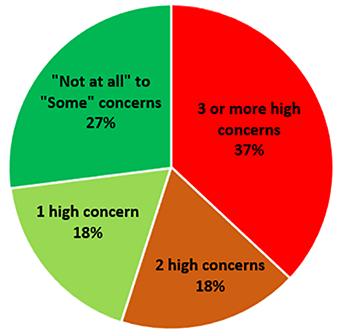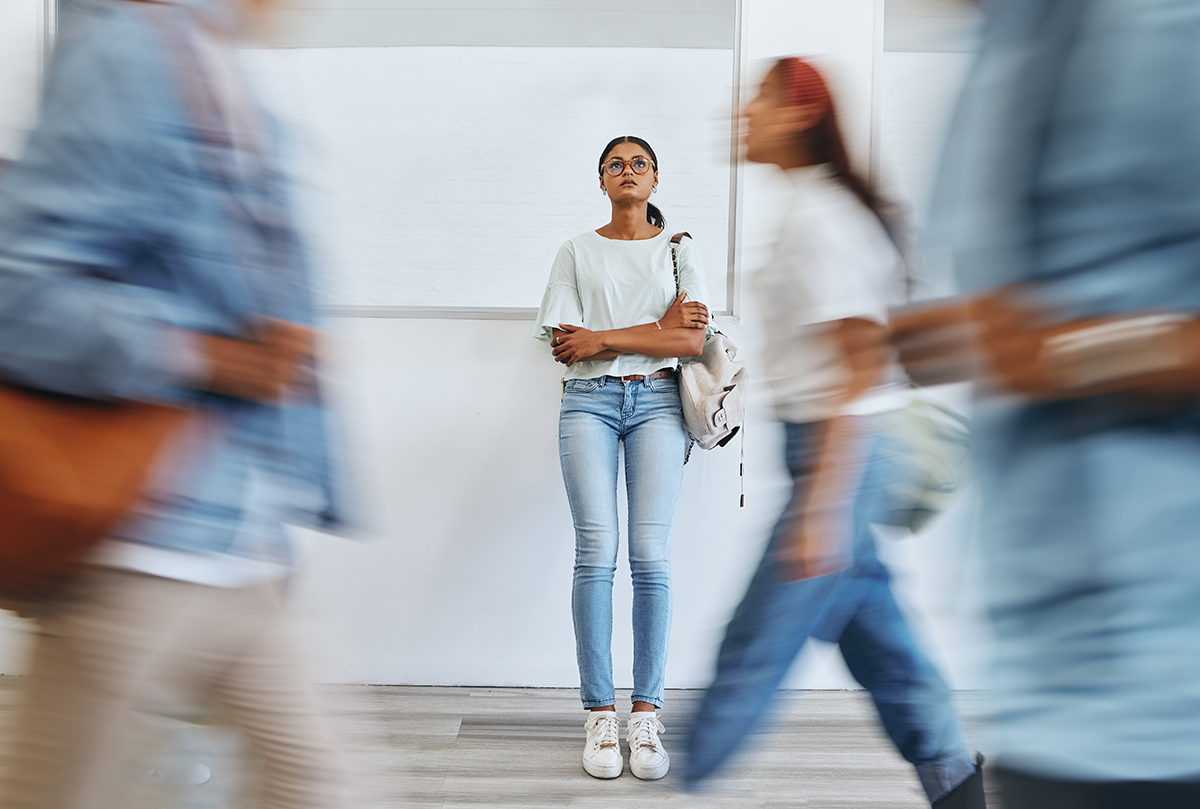As the country emerges from the COVID pandemic, it has become increasingly clear that another “pandemic” has arisen. Though college students' mental health and wellness has been a concern for many years, it has recently emerged as a widespread problem that can seriously impact academic success. The results below provide timely insight into the mental health and wellness concerns of entering first-year students. The data are from more than 50,000 students at 101 baccalaureate-level institutions who completed the Beginning College Survey of Student Engagement (BCSSE) during the summer or early fall of 2023.
Among the questions on the survey, students were asked, "During the coming school year, how concerned are you about the following?" As seen in Figure 1, avoiding mental and emotional exhaustion was the highest concern with 49% expressing "Very much" or "Quite a bit" concern. Less than 1/2 expressed high concern about Sleeping well and Maintaining positive mental health (44% and 42%, respectively). Feeling lonely and feeling homesick were less of a concern for most students, with 30% and 25% respectively.
Figure 1. During the coming school year, how concerned are you about the following? |
 |
Individually any one of these areas of high concern poses a challenge to students. However, students often experience more than one of these mental health and wellness challenges at the same time. When this co-occurrence is present, it points to an even more complex situation for institutions to address. We found a co-occurrence of 55% of high-level concerns (37% + 18%), indicating that nearly half of the entering first-year students this fall are challenged by a complex combination of mental health and wellness issues (Figure 2). It is heartening to note that 27% of students did not list any high-level concerns. It is also important to note that these numbers only reflect “high-level” concerns and do not reflect the cumulative effect of students indicating “Some” concern for multiple areas.
Figure 2. Co-occurrence of high-level concerns for entering first-year studentsa |
 |
a High-level concerns are those where the students expressed that they are "Very much" or "Quite a bit" concerned in one of the 5 mental health and wellness areas. |
We know from prior studies that student mental health and wellness are inextricably linked in a causal loop with academic success, where increasing concerns about mental health and wellness makes academic success more difficult and increased academic difficulty can increase mental health and wellness challenges. BCSSE includes questions about student “expected academic difficulty” during the coming year. While most students expected a moderate amount of academic difficulty, approximately 17% of students had low expected academic difficulty, while approximately 10% had a high level of expected academic difficulty. The results in Figure 3 show large differences between students with high and low expected academic difficulties and their concerns for their mental health and wellness. Though all the differences were significant, the largest difference was with feeling lonely. The average of 1.4 for students expecting low academic difficulty indicates on average these students were between “Very little” and “Some” concern about feeling lonely. However, the average of 2.4 for those expecting high academic difficulty indicates that on average these students are between “Some” and “Quite a bit” concerned about feeling lonely. It is also important to note that for students who expected high academic difficulty, their highest levels of concerns were for avoiding mental or emotional exhaustion (2.8), sleeping well (2.7), and maintaining positive mental health (2.7).
Figure 3. Mental health and wellness concerns by expected academic difficulty. |
 |
Prior studies also show the buffering effect of social integration on campus and mental health. Friendships and forming a social support network are positively associated with improved mental health and wellness. The results in Figure 4 further support the role of friendships and mental health and wellness. The results show large differences between students with high and low expected difficulty making friends and their concerns for their mental health and wellness (Figure 4). Similar to results in Figure 3, differences in Figure 4 were all significant, with feeling lonely having the largest difference. The average of 1.4 for students expecting low difficulty making friends indicates on average these students were between “Very little” and “Some” concern about feeling lonely. However, the average of 2.5 for those expecting high difficulty making friends indicates that on average these students are between “Some” and “Quite a bit” concerned about feeling lonely. It is also important to note that for for students with high expected difficulty making friends group, their highest levels of concerns were for avoiding mental or emotional exhaustion (2.8), sleeping well (2.6), and maintaining positive mental health (2.6) indicating concerns between “Some” and “Quite a bit”.
Figure 4. Mental health and wellness and expected difficulty making friends. |
 |
So what does this mean? It is heartening to note that more than one-quarter of all entering first year students for fall 2023 did not report high levels of concern regarding their mental health. However, that leaves significant numbers of students with high levels of concern regarding mental health and wellness. Since the COVID pandemic, many institutions have increased resources available to address these concerns. This study highlights not only the high-level concerns of first-year students who started college experience this fall, but also the extent to which they co-occur and are interconnected with student expected academic and social difficulties.
What action might educators take on this issue?
Midsemester is typically a time when many students are questioning their fit at the institution, and when combined with getting their first big test or assignment graded, they may be experiencing new stresses or are just feeling in the doldrums. Now is a good time for faculty to demonstrate care by offering academic support and reminding students about taking care of themselves. Remind students about the importance of sleep and its necessity for learning. Student life staff can offer more outreach to help students find a group or club to join to form those supportive friendship groups and to combat feelings of loneliness. Direct outreach asking students how they are doing, and encouraging students who express concerns about their mental health to take advantage of counseling services or other sources of support, are always well-timed.


